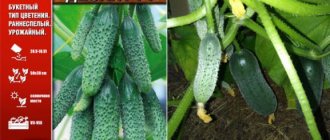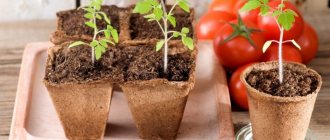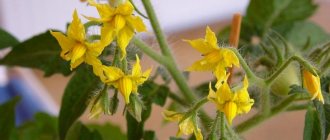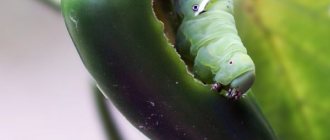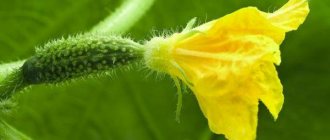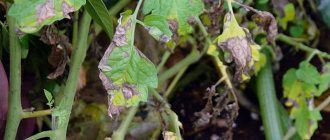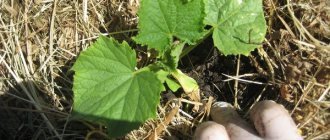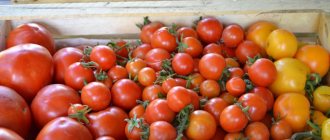How bees winter in a polycarbonate greenhouse
The success of any apiary depends to a large extent on the proper wintering of insects.
With a responsible approach to business, it is possible to reduce mortality among bees, save a lot of feed and ensure high productivity of their work in the coming season. In areas with cold but not too snowy winters, leaving hives in the open air is extremely irresponsible, so knowledgeable beekeepers erect special buildings on their plots, called omshaniks. The trouble is that many novice beekeepers cannot afford such luxury, so they have to get out of the situation in other ways. In this sense, wintering bees directly in a greenhouse built from polycarbonate is a good option, helping, on the one hand, to save money, and on the other, to provide the ability to control resting insects.
Preparing a greenhouse for bees
In the greenhouse, the hives are placed in a row as you can see in the video. There are no secrets in this matter. In order for bees to live comfortably and safely in their winter home, it is important to prepare it, as well as organize proper care for the insects:
- Make metal stands with legs for the hives (see thematic photos). They will protect bee colonies from mouse attack.
- Pre-treat the wooden outer parts of the hives with oil.
- Bee houses should be moved to the greenhouse when the ambient temperature requires it. Constant night frosts hit - send insects for the winter. This usually happens in November-December.
- Please note that in the first days after moving the hives, the temperature in the greenhouse will increase. Do not close the doors or windows during this period - let the bees adapt and calm down.
- After adaptation, close the ventilation and other openings. Open the upper entrances slightly (close the lower ones). Maintain this position for the entire wintering period of the bees.
- The hives will not become damp. Therefore, there is no need to dry them.
Attention! When preparing for wintering, take into account the characteristics of your bee breed.
What conditions must be met for successful wintering of bees?
Before placing a hive in a greenhouse for the winter, you should make sure that it:
• reliably protected from noise; • withstand strong winds; • will protect the internal space in case of sudden temperature fluctuations; • will ensure dry air.
Keep in mind that you will not be able to use a polycarbonate greenhouse without making certain changes to its design.
First of all, in order not to disturb the insects resting in bee houses in winter, you will need to limit the flow of light from the outside. The problem with greenhouses is that on sunny days the air in them heats up significantly, and this is undesirable. This can be eliminated by laying waterproof dark material on the roof of the greenhouse. The following will serve you as such for more than one year:
• black polyethylene film; • roofing felt; • glassine.
The inside of the greenhouse must also be equipped with thermal insulation. Reviews indicate that most often foam plastic (no thinner than 5 cm) or rolled foil polystyrene is used for this.
Among other things, it is extremely important for the beekeeper to ensure the correct humidity regime - the formation of condensation in the hives is unacceptable. In dampness, the bees will begin to get sick, and in addition, honey absorbs water well and then begins to deteriorate. For this reason, after moving the houses into the greenhouse, it should be well ventilated for the first few days. The optimal humidity level is 70-80 percent. It is better to control the level with a special device - a psychrometer. Adjustment is made using ventilation.
The hives also need to be protected from rodent infestations. To do this, they are placed on metal racks. It is necessary that the lower shelves are 40 centimeters above the floor. The strongest families are placed closer to the ground, and the weakest - in the second tier. If there are few hives, then prepare stands for them - they resemble tables with mesh or solid covers.
How to prepare bees
Before sending insects to spend the winter, they must be properly prepared - all activities begin in the second half of summer.
It is important to provide insects with food - honey is the best option for them. Its quantity is determined based on the norm: at least 8 kg of natural product is taken per kilogram of bees. That is, in a standard hive you will have to leave about 14-20 kg of food. In case of unforeseen situations, they keep an additional 10 kg per family in the warehouse.
The frames inside the hive should be correctly positioned - those that weigh more than 2 kg are placed closer to the place where the club is likely to be created. Full copper ones are placed on the edge.
Pay attention to the type of food. It is not recommended to leave it for the winter:
• honeydew honey; • sunflower; • collected from cruciferous crops.
Take care to keep late brood to a minimum. Fertilizing based on syrup will help with this. For it, take 2 liters of water and three kilograms of sugar. With this proportion, the food will remain liquid for a long time. To prevent it from fermenting, add a little citric acid.
In order to protect bees from illnesses during the entire period of their stay in greenhouses, it is recommended to mix the syrup with medications.
Another important point is that the hives are transferred to the greenhouse no earlier than the bees make their last flight.
Important nuances
- If you do not properly prepare for winter, the bee colony may weaken by spring. As a result, its pollinating activity will come to naught. The reasons for unsatisfactory wintering are the presence of sick families, late feeding or improper assembly of the nest.
- Different bee breeds have different winter hardiness. Some insects are able to withstand frost, while others die immediately.
- To ensure a good winter, it is necessary to prepare strong families in the fall. You also need high-quality food - 3 kilograms per street. The winter hut should have an optimal temperature.
- Every year it is recommended to replace the queens that are in the greenhouse. In the fall, one-year-olds lay eggs approximately 2 weeks longer than two-year-olds, and 20 days longer than three-year-olds.
It is necessary to prepare food for bees for the winter, according to some rules:
- insects overwinter best on light honey;
- in spring it is also better to give honey to bees;
- if the quality of honey is in doubt, then it is replaced with sugar by 50%;
- wintering occurs better if air space is left between the nest and the bottom;
- In winter, honeydew honey is not used, but it is good in the spring for building up the strength of the bee colony.
You can also learn about the rules for keeping chickens in greenhouses during the winter.
What to do with beehives
Hive preparation is also important:
• they are protected with sheet foam from the outside; • both entrances cover only a little; • frames filled with food are placed inside (low copper ones alternate with full ones); • complementary foods are covered with canvas, which is slightly raised at the back wall, providing access to fresh air; • a layer of moss is placed on top of the fabric; • At the end, the lid is pulled tightly on.
In such conditions the bees will feel as comfortable as possible.
After installing the hives, it is better not to enter the room unless absolutely necessary. Until February you only have:
• monitor the temperature (install a thermometer); • humidity; • inspect the hives once every two weeks.
In a darkened greenhouse you cannot do without light, but you can only use red lamps.
Pros and cons of using greenhouses
The advantage of a polycarbonate greenhouse is undoubtedly. Its advantages are determined primarily by:
• low cost; • ease of construction; • lightness.
If necessary, it is possible to organize the first flight in such a building - for this it is enough to turn on the heating.
At the same time, the greenhouse is beneficial for the beekeeper in that it provides maximum comfort, which makes the process of caring for the hives less labor-intensive.
The disadvantage is that the well-being of families has to be constantly monitored, which means that the polycarbonate greenhouse should be located near the house, because you are unlikely to be able to visit a remote dacha often.
At the same time, bees that go out for the first flight in the greenhouse sometimes lose the ability to navigate in space and crash against its transparent walls. A simple trick can protect you from this danger: place several frames of honey in the corners. Insects flock to them and no longer see the need to leave the location.
Features and types of wintering in a greenhouse
Experienced beekeepers can provide wintering for bees in different ways. In regions with unpredictable climatic conditions, it is advisable to use polycarbonate greenhouses, which allow you to control the condition of bee colonies during winter sleep. There are two types of wintering for bees: in nature and using special structures (winter huts). Insects are placed in such structures if the apiary is located in a harsh climate.
This design is least susceptible to wear and tear and is able to create favorable conditions for wintering. There are two ways to organize the wintering process in a greenhouse. The first of them involves placing insects in polycarbonate greenhouses, and the second - in an improved greenhouse. The most common winter shelter is a greenhouse constructed of polycarbonate.
There is nothing wrong with using the first option, but you must remember that in the spring such a structure will quickly heat up, and at temperatures above +10°C, insects will begin to fly out of the shelter and it will be difficult to lure them back. In the second option, it is advisable to cover a polycarbonate greenhouse in winter with roofing felt, which will prevent temperature fluctuations inside the room in the spring.
pros
- Placing bee colonies in a polycarbonate greenhouse has a number of advantages, including:
- affordable price and portability of assembly;
- saving weak families from death in regions with a mild climate;
- comfortable conditions for caring for hives in winter;
- protection of insects from external irritants;
- ensuring optimal temperature conditions and required air humidity.
Minuses
The only disadvantage of wintering bees in a greenhouse is that it must be under the constant supervision of a beekeeper. This option is suitable for those who live near the greenhouse.
Small but important nuances
Experienced beekeepers, in addition to the basic rules for keeping bees in greenhouses, have also identified a number of nuances that may become important for their readiness for spring flight:
- A bad winter with improper conditions for keeping bees will lead to the fact that by spring most of them will be weakened and even sick. Therefore, their activity will be minimal. The main problems that can make wintering unsuccessful are initially sick colonies, too late supplementation with honey and beebread, as well as improper assembly of the hive.
- Don't forget to consider that there are different breeds of bees. The way they overwinter may differ greatly from their variety. Some species tolerate frost well, while others can die at the slightest temperature change. Create optimal conditions that suit your pets.
- In addition to temperature and humidity, it is important to provide food for the bees in the greenhouse. Usually this is 3 kg of honey per street. Don’t forget to ensure that by autumn some of your bee colonies are strong and healthy.
- Keep an eye on the queens. It is recommended to replace the old queen, which has already survived winter once, with a young one every year. Young queens are able to lay eggs longer and more actively, creating a larger brood, which guarantees a larger and stronger family in the spring.
- Also take into account what exactly you feed the bees in the winter. It is best to use light honey for these purposes. It is also advisable to fertilize with it in the spring.
- Only if you have doubts about the quality of honey, it is recommended to replace it with half a serving of sugar.
- Beekeepers have noticed that if there is some space for air between the nest and the bottom, then wintering is more successful.
- In the spring, honeydew honey has proven itself well for feeding. It more actively restores and increases the strength of the bee colony.
This is interesting The drug Apisan for treating bees against mites
Preparatory work and care features
Preparing bee colonies for wintering is an important and time-consuming process. The survival of insects and the success of subsequent honey harvesting seasons depend on it. In this regard, the beekeeper is recommended to provide a decent wintering for the bees without losing members of their family.
The beekeeper must adhere to the following steps:
- Preparation of quality feed.
- Increasing the strength of the bee family.
- Formation of a nest and compliance with the necessary conditions for maintaining families.
Greenhouse heating
For maximum comfort in winter, hives should be prepared and insulated. The beekeeper must take care of the safety of his charges in advance. If an open type was chosen for wintering, then the hive should be insulated around the entire perimeter. To do this, you can use dry fodder, grass and foam. To reduce temperature fluctuations in the greenhouse, the structure should be covered with roofing felt.
Ventilation
The use of ventilation in a greenhouse is necessary to maintain temperature conditions. To regulate the heat inside the winter hut, it is recommended to use a door and a ventilation window. Overheating is contraindicated for insects, so on warm days it is recommended to ventilate the room.
Air humidity
Air humidity in the winter hut is measured with a psychrometer. If this device is not available, then you can use two identical thermometers and calculate this indicator yourself. The optimal air humidity in the greenhouse should be 75–85%. Bees get all the moisture they need in winter from honey feeding. Its level can be adjusted using temperature control and ventilation.
To reduce dampness in the greenhouse, you can also use ordinary rock salt or quicklime, otherwise the bees should be moved to another empty greenhouse. At the end of winter, insects produce brood, which leads to an increase in food consumption. As a result, the temperature in the greenhouse rises. To reduce it, it is recommended to install bars in doorways, and at night you should open the door slightly.
Preparing bees for awakening
Closer to spring, brood will appear in your apiary. Care during this period will be different. The bees will become more active, require more food, and the greenhouse will become warmer. It is important not to miss this time and use ventilation to lower the temperature. For example, open the door slightly at night by inserting a grille into it. Artificially increasing humidity also helps.
At the end of winter, the bees need to be given honeycombs, which should first be sprinkled with melt water. Place the honeycomb parts on 2 1x1 cm bars in frames and cover with the same blocks. Then lay out the canvas. With the right diet, hives can be taken outside as early as March, provided frosts have passed.
Wintering bees is not the easiest procedure. Violation of technology will lead to weakening and illness of some insects. Errors include a late start of supplementary feeding, incorrect assembly of the house, drafts and too low a temperature. In the coming season, the activity of such bees will decrease significantly.
Ways to feed bees in winter
In order for individuals to successfully survive the winter and survive, they must be fed. At this time, insects can be given honey or specially brewed syrup. Feeding with honey is quite an expensive pleasure, so beekeepers use other methods that depend on wintering conditions. If it was not possible to collect high-quality honey or it has already crystallized, you can feed the insects using frames.
The bee club will have a food supply of 1.5 to 2 kg until spring. It should be remembered that the correct calculation of the quality and quantity of feeding is a guarantee of a successful wintering of the swarm. The beekeeper should be especially careful towards the end of winter. Any carelessness can provoke insects to fly around the area, and because of this they can freeze in the cold.
It is necessary to use syrup as complementary food with caution, since it can lead to intestinal upset of insects and depletion of their body. Such a delicacy should not be liquid, otherwise the mixture may ferment over time and become unfit for consumption. The composition of the syrup must contain all the necessary nutrients for the insect's body.
To prepare honey-sugar syrup, you can follow the following recipe and algorithm:
- Pour sugar into slightly cooled boiling water and dissolve.
- After the syrup has cooled to the optimal temperature (+40°C), you need to add honey.
- The resulting mixture should be poured into pre-prepared feeders. If you don't have them on hand, you can use bags.
Features of care
When a bee colony enters a greenhouse, the internal temperature in the structure rises during the first few days.
This is a natural process. To prevent bees from worrying, experienced beekeepers recommend increasing air circulation - opening doors and vents slightly. When the bees calm down, you should open the hive entrance. The greenhouse is heated by foam boards. The ideal version of bee wintering is this: the lower entrance is completely closed, and the upper one is slightly open. Such a hive will not become damp. Bees do not like noise and disturbance, so it is not advisable to visit the greenhouse frequently.
The brood is born closer to spring. By this period, insects begin to become more and more agitated and need more honey. One kilogram of honey requires one cubic meter of air. As a result, the following will be released: several kilojoules of heat, 1.5 kg of carbon dioxide and 700 g of water. Because of this, the temperature in the greenhouse will rise again. It is advisable to reduce it. It is recommended to open the door or window at night, after closing it with a grill. If the temperature in the greenhouse exceeds +5 degrees, it is necessary to increase the humidity.
There is no need to listen to the bees while the hive is in the greenhouse. Just a quick glance is enough. If the hum is smooth and calm, everything is fine . At low temperatures, weak hives emit a loud hum, and at high temperatures, on the contrary, strong ones. When there is a strong hum, it is necessary to ventilate and refresh the room, and when there are weak bees, close all the windows and doors .
If, amid the general hum of the hive, the sounds of individual bees are heard, it means something happened to the queen . If fears and doubts are confirmed, it is necessary to place weakened bees that have a queen in this family.
Advice from experienced beekeepers
For a successful wintering of bees, experienced beekeepers advise adhering to the following basic rules and recommendations:
- maintaining complete peace and darkness in the winter hut, since sound and light can lure bees out of the hives;
- prevent the entry of rodents that can damage the hive or disturb insects;
- regularly listen to the noise in the hive, which will help diagnose the condition of the whole family: the absence of noise signals the bees are starving, and high noise indicates crystallization of food.
Every beekeeper thinks about how to organize the wintering of their insects. So, in order to successfully overcome the cold season, it is necessary to follow the rules for heating the greenhouse, the temperature regime and not to forget about equipping the room with ventilation.
Wintering bees in a polycarbonate greenhouse
An important component of successful beekeeping is the proper organization of wintering. It allows you to reduce the inevitable loss of bees to a minimum and affects productivity in the new season. For physiologically strong bee colonies, wintering in the wild is preferable, even in harsh climatic conditions. But for weakened bees, such a winter may be the last.
In regions with frosty winters and little snow, keeping bees in the wild is generally impractical, so beekeepers are forced to set up special premises. The use of polycarbonate greenhouses instead of the usual omshanik is one of the best options, allowing to reduce financial costs and providing the necessary control over the condition of a bee colony (or several) during the winter dormancy period.
Features of the design of a greenhouse for wintering bees
An ordinary polycarbonate greenhouse can be used in winter as a greenhouse.
The main functions that a bee wintering room should perform:
- protection from noise, temperature changes and strong winds;
- creating an optimal air humidity regime;
- feed savings;
- extending the service life of hives.
If we leave the greenhouse in its original form, it will not be able to fully fulfill all its tasks. So, on sunny days it will heat up more than on cloudy days. The situation can be corrected by laying a light-proof material on top of the polycarbonate sheets - roofing felt or glassine. And in order to protect the room even more reliably from temperature changes, it’s a good idea to add additional thermal insulation on the inside. Insulation made from foamed polystyrene or sheet foam are suitable for this purpose.
Thermal insulation will protect not only from frost. With the arrival of spring, when it becomes warm outside, the shelter will be cooler, so the bees will not fly out of the hive prematurely. Regulate the temperature in the room using ventilation vents and doors. So, at the very beginning of wintering, when the weather is constantly changing, the beekeeper will have to be very careful and control the temperature regime. Overheating is especially harmful for bees, so keep the windows and doors open on warm days, and close them on cold days.
Important! The difference in temperature between the room and the hive contributes to increased humidity. Monitor the air humidity in the greenhouse using measuring instruments. The normal value is in the range of 75-80%. Adjustment of indicators is achieved by increasing or decreasing the flow of fresh air.
When placing hives in winter, be sure to take care of protection from rodents. Make special metal stands for the hives, and protect the entrance with a metal mesh. If there are a lot of hives and you have to arrange them in two tiers, then make racks from metal profiles or fittings. Place the hives with the strongest families at the bottom, and place the weak ones at the top.
Polycarbonate prices
Ventilation and humidity parameters
One of the important conditions for bees to feel good in winter is proper ventilation. Only by creating optimal air conditions can you be sure that the honey will not spoil and the bees will feel good. To do this, certain conditions must be met:
- the optimal level of humidity for bees in winter in a greenhouse should be between 75 and 85 percent;
- when the hives are just brought into the greenhouse, it is better to open the doors for an additional few days, as the humidity will immediately rise;
- if the air is too dry, you should additionally water the floor or place a bucket of water and salt;
- If the humidity is too high, honey will quickly sour and spoil. The bees will have nothing to eat in winter. In dry air, it will dry out and also become not very suitable.
This is interesting How to get rid of hornets
Some beekeepers use the so-called psychrometer the old fashioned way. To do this, take two ordinary thermometers. One of them is wrapped in gauze or cambric, making a small ball out of the fabric. The ends of the fabric are dipped into water. By monitoring the humidity of the ball, you can see how dry the air is in the greenhouse.
The second thermometer is placed as usual. In this case, a psychrometer table is used and the humidity level in the room is determined by the difference in indicators between thermometers.
Preparing bees for winter
The biological health of bees is of paramount importance for successful wintering. Bees that work on honey collection before the onset of cold weather rarely survive until the next season. The situation is similar with bees raising brood in September or October. An experienced beekeeper begins to prepare bee colonies for wintering in mid-summer.
Honey after summer pumping must be left in sufficient quantity to feed the bees during wintering. On average, 1 kg of live weight of bees consumes 8 kg of honey over the winter. In practice, this amount depends on wintering conditions and the breed of bees.
Table. Average data on feed consumption.
Before sending bee colonies for the winter, collect nests. For a family with 2.5 kg of live weight, when assembling, you will need to leave 15 to 20 kg of high-quality honey in the nest and a stock of about 10 kg in the warehouse. It is more convenient to send strong families for the winter in two-hull hives, with most of the food supply located in the upper building.
It is important to place the frames correctly in the hive. Those of them where it is planned to form a club must have a supply of honey of at least 2 kg. Full copper frames should be placed around the edges of the hive. With the correct configuration of the nest, full-copper and low-copper frames alternate with each other - this prevents the death of bees with sufficient food supplies due to the fact that they were unable to reach the frames with honey.
Important! The feed stock should not include frames with honeydew honey or honey from the last harvest from crops such as sunflower or cruciferous plants. Before wintering, they must be replaced with frames with summer honey, previously left for these purposes.
To stop late brood, feed the bees with sugar syrup. Optimally for making syrup, add sugar at the rate of 3 kg per 2 liters of water. Increasing the concentration may cause the syrup to crystallize and make it difficult for bees to use. A weaker solution may turn sour - to avoid this situation, we recommend adding a little acetic or citric acid to the finished syrup. The cooking rule is to first boil water and then add sugar. Otherwise, it simply will not dissolve completely. It is not recommended to boil the syrup for a long time; it is better to simply remove it from the heat after adding sugar and stir thoroughly until completely dissolved. Feeding should be plentiful.
Caring for insects in winter
During all 3 winter months, try not to disturb the bees. Do not enter the greenhouse unless absolutely necessary. The main care for it during this period is removing snow if its layer threatens the integrity of the greenhouse.
Control the humidity and temperature in the room where bees hibernate
A uniform hum from the hives indicates the normal condition of the bees. Weak hives increase the hum at low temperatures, strong hives, on the contrary, at high temperatures. Accordingly, you will need to either reduce the flow of cold air or ventilate.
Attention! The hum of individual insects indicates illness or death of the queen. After checking, moving a weak family to this hive will help correct the situation.
The normal humidity level in a greenhouse is 75-85%. With other values, honey will be of poor quality. Dry winter air is characteristic, in particular, of Siberia. In this situation, watering the floor with water helps. If it is too humid for the bees, open the window and slightly warm up the room - the excess moisture will disappear. Another method is to place buckets of salt near the hives.
Beekeepers' nutrition tips:
- In winter and spring, it is better to feed insects with light honey;
- also in the spring they are given honeydew honey to strengthen their strength;
- in a greenhouse it is better to feed insects at the rate of 3 kg of product per hive;
- You can replace part of the honey diet with sugar if its quality is of concern.
Preparing the uterus is a very important stage
The successful wintering of a bee colony directly depends on the health, age and quality of the queen. Young one-year-old queens produce the highest brood. A good technique for sending a family with a strong queen to winter is the use of temporary layering. Bees from temporary layers are combined with the main colonies, old queens are replaced with fresh ones.
For ease of work, each uterus should be marked with coloring. One-year-olds - one color, two-year-olds - another, etc. In this way, it is easy to cull the old queen and replace it with a younger one. In large apiaries, it is advisable to assign a number to each queen and attach it to the hive in which she is placed. When the queen is moved to another hive, the number is moved with her. It is recommended to keep a separate notebook for each hive with records of work performed, indicating dates and times. This makes caring for bee colonies very easy.
Important Features
Wintering for bees can be organized in completely different ways - in a barn, haystack, etc. But the most favorable option would be a greenhouse made of polycarbonate. It is recommended to insulate its interior with sheets of foam plastic, carefully sealing possible joints and holes. Humidity and temperature in the greenhouse have a huge impact on the wintering of bees, so it is necessary to carefully monitor these indicators. Bees should be fed with high-quality, light-colored honey and their hive should not be disturbed again. By following these recommendations, you will thoroughly prepare for wintering, provide proper winter care for your bees, and in the spring your workers will fly out of the greenhouse healthy and full of strength.
- If you do not properly prepare for wintering, the bee colony can become very weak in the spring. As a result, its activity in pollinating flowers and collecting honey will weaken. The main reasons for poor wintering are: improper assembly of the bee nest, the presence of sick families in the hive, late feeding.
- Frost resistance varies among different bee species. Some bees can withstand even the coldest winter, while others die instantly.
- For proper wintering, you need to prepare strong families in the fall. You need to prepare high-quality and good food - 3–3.5 kg per street. The temperature in the greenhouse should be acceptable.
- It is recommended to annually change the queens that were present in the greenhouse. By the way, one-year-old queen bees lay eggs on average two weeks longer than two-year-old queens, and three weeks more than three-year-old queens.
Preparing food for bees should be done according to the following recommendations:
- Good wintering depends on the color of the honey. The lighter it is, the better it is for insects.
- In spring, it is also advisable to give honey to the bees.
- If the honey is of poor quality, it is diluted with sugar in a 1:1 ratio.
- Wintering will be especially good for insects if you make a small air gap between the nest and the bottom of the hive.
- In winter, honeydew honey is not recommended for use, but in spring it comes in handy to increase the strength of the bee colony.
Preparing the hives
In an unheated greenhouse, it is recommended to insulate the hives from the outside. It is convenient to use foam sheets for these purposes. The upper and lower tapholes should be left open, slightly reducing the width of the gap. Inside the hive, complementary food is placed on a stocked nest and covered with canvas. Near the back wall, the canvas is turned back a little to create conditions for better ventilation of the hive.
An insulating cushion of moss or other loose and hygroscopic material is placed on the canvas, and then the top cover is installed.
After the hives are prepared and placed for wintering in compliance with all standards, the beekeeper is not recommended to disturb the peace of the bees with his presence. Limit yourself to controlling temperature and humidity and occasionally (no more than twice a month) conduct a visual inspection of the hives. If the bees feel uncomfortable in any of them, which you can tell by the uncharacteristic buzzing of the hive, carefully open it and check for the reason.
When inspecting in darkened greenhouses, turn on the lighting in red.
How to determine the best time to exhibit bees for the winter
Autumn weather is changeable. After short-term cold weather, warming may occur. Prepared hives are placed in a permanent wintering place only with the onset of stable negative temperatures. This way you give the bees the opportunity to make a quality pre-winter flight. The hives must be well dried before the exhibition, so they cannot be moved to the wintering site in inclement weather - only a dry day is suitable for this. A suitable time of day is late evening or even night. At this time, all the bees have already returned to the hive and their activity is minimal.
Growing eggplants in a polycarbonate greenhouse
In warm climates it is grown in open ground, but in those regions not spoiled by heat, eggplants are planted only in greenhouses. You will find more detailed information about this in this article.
Advantages and disadvantages of polycarbonate greenhouses for wintering bees
Using greenhouses for wintering has many advantages. Let's list just a few.
- Low cost and ease of installation. The finished greenhouse can be easily installed in one day.
- For regions with a mild climate, the use of greenhouses allows you to save weak families from death.
- If the bees did not have time to fly around before wintering, then it is easy to create conditions for flying around in the greenhouse by simple heating. This can also be done at the end of winter, when the bees already need to cleanse their intestines, but the weather is not yet very suitable for exhibiting outside.
- Winter care of hives is carried out in comfortable conditions.
- At subzero outside temperatures, bees are not disturbed by daylight. If your greenhouse maintains indoor temperatures between 0 and 4 degrees Celsius, apply shade to prevent bees from being disturbed. Also make sure there is no noise.
- For areas with rainy autumn months, you can prepare nests directly in the greenhouse. If the temperature outside is still high, then the prepared hives should be taken outside before the onset of stable cold weather.
Important! The only disadvantage that should be highlighted is that the wintering of bees in a greenhouse must be under constant supervision. This option is only acceptable if the greenhouse is located near the beekeeper’s place of residence. This method is not suitable as a country option.
When flying around in greenhouses, bees often lose orientation, a certain percentage of them die - they fly without noticing barriers made of transparent material, and lose strength trying to break through them. The situation can be corrected by placing frames of honey in the corner for drying. A busy bee will not become disoriented.
Bee products are not only sweet and aromatic honey. Propolis is used in medicine, folk healers use death, cosmetologists add wax to the composition of miraculous ointments, it is widely used in the manufacture of candles and other areas. Bee stings have a healing effect for many ailments.
The work of a beekeeper is very difficult and full of risks. A lazy person shouldn't even try to keep bees. In addition to a large amount of knowledge, which must be constantly replenished with your personal observations and experiments, an apiary requires a large investment of physical labor and financial investments. The most persistent and persistent beekeepers achieve success.
Heating, ventilation, humidity
When bees enter the greenhouse, the temperature in the building rises in the first days. In this case, it is recommended to open hatches, doors and ventilation pipes slightly so that the insects do not feel disturbed. After the bees have calmed down, you can open the entrance slightly. The building is heated using foam plates, according to the scheme indicated earlier.
The optimal option for keeping bees in a greenhouse is that the lower entrance is closed and the upper one is slightly open. This way there will be no dampness in the hive. Insects do not like to be disturbed, so visiting the greenhouse is often not recommended.
Brood appears closer to spring. At the same time, the bees begin to worry and need more honey. For a kilogram of honey you need 1 kilogram of air. What will be released is heat, one and a half kilograms of carbon dioxide and half a kilogram of water. As a result, the temperature in the building will begin to rise again. If possible, it is recommended to reduce it. Open the front door slightly at night, after placing a grill on it. If the room temperature rises above +4, increase the humidity.
Honeydew honey is not used in winter, but it is good in spring for building the strength of the bee colony
There is no need to listen to bees when you are in a greenhouse. If the hum is smooth, then everything is in order. At low temperatures, weak hives buzz more loudly; at elevated temperatures, on the contrary, strong ones buzz. If strong bees are humming, you should ventilate the room; if weak bees are humming, reduce the flow of cold air.
If you hear sounds from individual insects, it means something has happened to the queen. If the fear is confirmed, a weakened family that has a queen should be placed in the hive.
